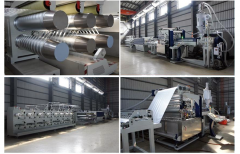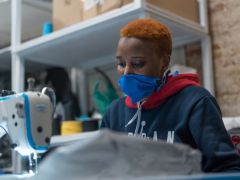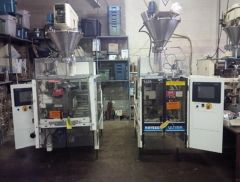Search results for: 'Pad ther'
- Related search terms
- Thermobondin
- Pad d
- Thermal
- thermal b
- thermal b'
-
 TT-4788 THERMOSOL MONFORTS, WORKING WIDTH 1800mm, YEAR 1989TT-4788 THERMOSOL MONFORTS, WORKING WIDTH 1800mm, YEAR 1989 THERMOSOL MONFORTS MODEL PADDER: MATEX COLOR MAX LINEAR PRESSURE: 50DA/CM AIR PASSAGE: LENGHT 12MROLL DIAMETER 140mm WET MECHANISM FOR CLEANING QUANTITY: 1 Learn More
TT-4788 THERMOSOL MONFORTS, WORKING WIDTH 1800mm, YEAR 1989TT-4788 THERMOSOL MONFORTS, WORKING WIDTH 1800mm, YEAR 1989 THERMOSOL MONFORTS MODEL PADDER: MATEX COLOR MAX LINEAR PRESSURE: 50DA/CM AIR PASSAGE: LENGHT 12MROLL DIAMETER 140mm WET MECHANISM FOR CLEANING QUANTITY: 1 Learn More -
 J-3004 FIBRILLATED RAFFIA TAPE EXTRUSION LINE – NEW, 120mmJ-3004 FIBRILLATED RAFFIA TAPE EXTRUSION LINE – NEW, 120mm PP FIBRILLATED YARN EXTRUDER LINE MODEL: NOVASTAR-120 EXTRUSION LINE FOR PRODUCTION OF PP FIBRILLATED YARN RAW MATERIAL: PP GRANULE FINISHED PRODUCTS: NON-TWISTED TAPE YARN, FIBRILLATED YARN FOR TWINE RANGE OF PRODUCT: 10,000 TO 30,000 DENIER 10000 DENIER APPROXIMATELY 17 TO 19 YARN 16000 DENIER APPROXIMATELY 11 TO 12 YARN 22000 DENIER APPROXIMATELY 8 TO 9 YARN 28000 DENIER APPROXIMATELY 6 TO 7 YARN 32000 DENIER APPROXIMATELY 5 TO 6 YARN EXTRUSION THROUGHPUT: 300 KG PER HOUR EXTRUSION CAPACITY: 180 TO 250 KG PER HOUR (PRODUCT CAPACITY DEPEND ON FILAMENT SIZE) EXTRUDER SCREW DIAMETER: Ø 120mm T-DIE WIDTH: 1300mm TAKE-OFF ROLLER WIDTH: 1200mm TAKE-OFF LINE SPEED: 160 METERS PER MINUTE (MAXIMUM) OPERATION SIDE: RIGHT TO LEFT, OR LEFT TO RIGHT Learn More
J-3004 FIBRILLATED RAFFIA TAPE EXTRUSION LINE – NEW, 120mmJ-3004 FIBRILLATED RAFFIA TAPE EXTRUSION LINE – NEW, 120mm PP FIBRILLATED YARN EXTRUDER LINE MODEL: NOVASTAR-120 EXTRUSION LINE FOR PRODUCTION OF PP FIBRILLATED YARN RAW MATERIAL: PP GRANULE FINISHED PRODUCTS: NON-TWISTED TAPE YARN, FIBRILLATED YARN FOR TWINE RANGE OF PRODUCT: 10,000 TO 30,000 DENIER 10000 DENIER APPROXIMATELY 17 TO 19 YARN 16000 DENIER APPROXIMATELY 11 TO 12 YARN 22000 DENIER APPROXIMATELY 8 TO 9 YARN 28000 DENIER APPROXIMATELY 6 TO 7 YARN 32000 DENIER APPROXIMATELY 5 TO 6 YARN EXTRUSION THROUGHPUT: 300 KG PER HOUR EXTRUSION CAPACITY: 180 TO 250 KG PER HOUR (PRODUCT CAPACITY DEPEND ON FILAMENT SIZE) EXTRUDER SCREW DIAMETER: Ø 120mm T-DIE WIDTH: 1300mm TAKE-OFF ROLLER WIDTH: 1200mm TAKE-OFF LINE SPEED: 160 METERS PER MINUTE (MAXIMUM) OPERATION SIDE: RIGHT TO LEFT, OR LEFT TO RIGHT Learn More -
 D-2388 What’s the Best Material for a Mask?
D-2388 What’s the Best Material for a Mask?Federal health officials have now recommended that we cover our faces with fabric during the coronavirus pandemic. But what material offers the most protection?
The Centers for Disease Control and Prevention has posted a no-sew mask pattern using a bandanna and a coffee filter as well as a video on making masks using rubber bands and folded fabrics found at home.
While a simple face covering can reduce the spread of coronavirus by blocking outgoing germs from coughs or sneezes of an infected person, experts say there is more variation in how much homemade masks might protect the wearer from incoming germs, depending on the fit and quality of the material used.
Scientists around the country have taken it upon themselves to identify everyday materials that do a better job of filtering microscopic particles. In recent tests, HEPA furnace filters scored well, as did vacuum cleaner bags, layers of 600-count pillowcases and fabric similar to flannel pajamas. Stacked coffee filters had medium scores. Scarves and bandanna material had the lowest scores, but still captured a small percentage of particles.
If you don’t have any of the materials that were tested, a simple light test can help you decide whether a fabric is a good candidate for a mask.
“Hold it up to a bright light,” said Dr. Scott Segal, chairman of anesthesiology at Wake Forest Baptist Health who recently studied homemade masks. “If light passes really easily through the fibers and you can almost see the fibers, it’s not a good fabric. If it’s a denser weave of thicker material and light doesn’t pass through it as much, that’s the material you want to use.”
Researchers say it’s important to remember that lab studies are conducted under perfect conditions with no leaks or gaps in the mask, but the test methods give us a way to compare materials. And while the degree of filtration for some homemade masks seems low, most of us — who are staying home and practicing social distancing in public — don’t need the high level of protection required for medical workers. More important, any face covering is better than none, especially if worn by a person who has the virus but doesn’t know it.
The biggest challenge of choosing a homemade mask material is to find a fabric that is dense enough to capture viral particles, but breathable enough that we can actually wear it. Some items being touted online promise high filtration scores, but the material would be unwearable.
Dressing Up for Work … at Home
Yang Wang, an assistant professor of environmental engineering at Missouri University of Science and Technology, worked with his graduate students to study various combinations of layered materials — including both air filters and fabric. “You need something that is efficient for removing particles, but you also need to breathe,” said Dr. Wang, who last fall won an international award for aerosol research.To test everyday materials, scientists are using methods similar to those used to test medical masks, which everybody agrees should be saved for medical workers who are exposed to high doses of virus from seeing infected patients. The best medical mask — called the N95 respirator — filters out at least 95 percent of particles as small as 0.3 microns. By comparison, a typical surgical mask — made using a rectangular piece of pleated fabric with elastic ear loops — has a filtration efficiency ranging from 60 to 80 percent.
Dr. Wang’s group tested two types of air filters. An allergy-reduction HVAC filter worked the best, capturing 89 percent of particles with one layer and 94 percent with two layers. A furnace filter captured 75 percent with two layers, but required six layers to achieve 95 percent. To find a filter similar to those tested, look for a minimum efficiency reporting value (MERV) rating of 12 or higher or a microparticle performance rating of 1900 or higher.
The problem with air filters is that they potentially could shed small fibers that would be risky to inhale. So if you want to use a filter, you need to sandwich the filter between two layers of cotton fabric. Dr. Wang said one of his grad students made his own mask by following the instructions in the C.D.C. video, but adding several layers of filter material inside a bandanna.
Dr. Wang’s group also found that when certain common fabrics were used, two layers offered far less protection than four layers. A 600 thread count pillow case captured just 22 percent of particles when doubled, but four layers captured nearly 60 percent. A thick woolen yarn scarf filtered 21 percent of particles in two layers, and 48.8 percent in four layers. A 100 percent cotton bandanna did the worst, capturing only 18.2 percent when doubled, and just 19.5 percent in four layers.
The group also tested Brew Rite and Natural Brew basket-style coffee filters, which, when stacked in three layers, showed 40 to 50 percent filtration efficiency — but they were less breathable than other options.
If you are lucky enough to know a quilter, ask them to make you a mask. Tests performed at the Wake Forest Institute for Regenerative Medicine in Winston-Salem, N.C., showed good results for homemade masks using quilting fabric. Dr. Segal, of Wake Forest Baptist Health, who led the study, noted that quilters tend to use high-quality, high-thread count cotton. The best homemade masks in his study were as good as surgical masks or slightly better, testing in the range of 70 to 79 percent filtration. Homemade masks that used flimsier fabric tested as low as 1 percent filtration, Dr. Segal said.
The best-performing designs were a mask constructed of two layers of high-quality, heavyweight “quilter’s cotton,” a two-layer mask made with thick batik fabric, and a double-layer mask with an inner layer of flannel and outer layer of cotton.
Bonnie Browning, executive show director for the American Quilter’s Society, said that quilters prefer tightly woven cottons and batik fabrics that stand up over time. Ms. Browning said most sewing machines can handle only two layers of fabric when making a pleated mask, but someone who wanted four layers of protection could wear two masks at a time.
Ms. Browning said she recently reached out to quilters on Facebook and heard from 71 people who have made a combined total of nearly 15,000 masks. “We quilters are very much in the thick of what’s going on with this,” said Ms. Browning, who lives in Paducah, Ky. “One thing most of us have is a stash of fabric.”
People who don’t sew could try a folded origami mask, created by Jiangmei Wu, assistant professor of interior design at Indiana University. Ms. Wu, who is known for her breathtaking folded artwork, said she began designing a folded mask out of a medical and building material called Tyvek, as well as vacuum bags, after her brother in Hong Kong, where mask wearing is common, suggested it. (DuPont, the maker of Tyvek, said in a statement that Tyvek is intended for medical apparel, not masks.) The folded mask pattern is free online, as is a video demonstrating the folding process. In tests at Missouri University and University of Virginia, scientists found that vacuum bags removed between 60 percent and 87 percent of particles. But some brands of vacuum bags may contain fiberglass or are harder to breathe through than other materials, and shouldn’t be used. Ms. Wu used a bag by EnviroCare Technologies, which has said it does not use fiberglass in its paper and synthetic cloth bags.
“I wanted to create an alternative for people who don’t sew,” said Ms. Wu, who said she is talking to various groups to find other materials that will be effective in a folded mask. “Given the shortage of all kinds of materials, even vacuum bags might run out.”
The scientists who conducted the tests used a standard of 0.3 microns because that is the measure used by the National Institute for Occupational Safety and Health for medical masks.
Linsey Marr, a Virginia Tech aerosol scientist and an expert in the transmission of viruses, said the certification method for respirators and HEPA filters focuses on 0.3 microns because particles around that size are the hardest to catch. While it seems counterintuitive, particles smaller than 0.1 microns are actually easier to catch because they have a lot of random motion that makes them bump into the filter fibers, she said.
“Even though coronavirus is around 0.1 microns, it floats around in a wide range of sizes, from around 0.2 to several hundred microns, because people shed the virus in respiratory fluid droplets that also contain lots of salts and proteins and other things,” said Dr. Marr. “Even if the water in the droplets fully evaporates, there’s still a lot of salt and proteins and other gunk that stays behind as solid or gel-like material. I think 0.3 microns is still useful for guidance because the minimum filtration efficiency will be somewhere around this size, and it’s what NIOSH uses.”
Learn More -
 R-3243 COFFEE ROASTERS COMPLETE PLANT TAKE OVER, CAPACITY 4,200 LBS PER HOUR
R-3243 COFFEE ROASTERS COMPLETE PLANT TAKE OVER, CAPACITY 4,200 LBS PER HOURR-3243 COFFEE ROASTERS COMPLETE PLANT TAKE OVER, CAPACITY 4,200 LBS PER HOUR
TWO (2) COMPLETELY AUTOMATIC AND DIGITAL JABEZ BURNS 23R 4 BAG ROASTERS, PROGRAMMED RECIPES, AUTOMATED BUCKET ELEVATORS, DESTONER, MICRO FILTER GREEN BEAN CLEANER, AFTERBURNER FOR BOTH ROASTERS INCLUDES:
- FIRST ROASTER: JABEZ BURNS GAS-FIRED BATCH COFFEE ROASTER, MODEL 23R ACO THERMALO, (MODEL 23R-02309 ON CONTROL PANEL), C/W MAXON OVENPAK GAS BURNER, MODEL 400, SIZE 422M, (ROASTER REBUILT 2013), C/W JABEZ BURNS AUTOMATIC CONTROL CONSOLE C/W ALLEN-BRADLEY PLC MODEL MICROLOGIX 1500, ALLEN-BRADLEY HMI CONTROL MODEL PANELVIEW 550, PRINTER, & WORKSTATION, (ROASTER "A")
- SECOND ROASTER: JABEZ BURNS GAS-FIRED BATCH COFFEE ROASTER, MODEL 23R ACO THERMALO (MODEL 23R-04307 ON CONTROL PANEL), C/W MAXON OVENPAK GAS BURNER, MODEL 400, SIZE 422M, (ROASTER REBUILT 2013), C/W JABEZ BURNS AUTOMATIC CONTROL CONSOLE C/W ALLEN-BRADLEY PLC MODEL MICROLOGIX 1500, ALLEN-BRADLEY HMI CONTROL MODEL PANELVIEW 550, PRINTER, & WORKSTATION, (ROASTER "B")
- TWO: JABEZ BURNS COOLER/STIRRER/DE-STONER MODEL STIRFLEX C/W AIRVEYING DISCHARGE DUCT, ERIEZ MAGNET MODEL 20" RE RPS, STYLE 9706716, W/ S/S ENCLOSURE, & S/S HOOD W/ LIGHTING
- S/S EXHAUST HOOD OVER COFFEE DUMP BIN C/W EXHAUST FAN & DUCTING
- UNIVERSAL BUCKET ELEVATOR W/ AIRVEYING PIPE TO GREEN BEAN CLEANER
- HAMATEC ROTARY SCREEN GREEN BEAN CLEANER, TYPE KSD500/1200AM, (2007), C/W LEESON AC VARIABLE SPEED MOTOR CONTROL
- MACTIFLO DUST COLLECTOR W/ DRUM DISCHARGE, C/W NATIONAL CONTROLS INTELLIGENT DUST CONTROL MODEL DNC-T2310-A10
- UNIVERSAL BUCKET ELEVATOR (FROM GREEN BEAN CLEANER), MODEL D3-100ED, C/W PNEUMATIC DISCHARGE GATE, (2) BEAN LOADING CONTROL PANELS, & (2) AIRVEYING PIPES TO ROASTER "A" & ROASTER "B"
- TWO: ROASTED COFFEE BEAN ELEVATED HOLDING BIN C/W PNEUMATIC DISCHARGE GATE & AIRVEYING DISCHARGE PIPE
- CIRCULATING BLOWER FOR ROASTING LINE "A" C/W SUPPORT PLATFORM
- ELEVATED CHAFF COLLECTION CYCLONE W/ DRUM DISCHARGE
- CIRCULATING BLOWER FOR ROASTING LINE "B" C/W SUPPORT PLATFORM
- MARS 4' X 4' FLOOR PLATFORM SCALE C/W DIGITAL WEIGHT INDICATOR, MODEL MSF-445, 5,000 LB. CAP. (SUBJECT TO CONFIRMATION) 24" X 30" PLATFORM SCALE C/W DIGITAL WEIGHT INDICATOR
- INPROHEAT INDUSTRIES NATURAL GAS THERMAL OXIDIZER AFTERBURNER, MAX. INPUT 1.4MM BTU/HR C/W MAXON OVENPAK-II GAS BURNER, SIZE 425, CONTROL PANEL C/W TEMPERATURE RECORDER AND HONEYWELL BURNER CONTROL
Learn More -
 E-4553INVENTORY NUMBER: E-4553 FOAM MACHINERY FOR SALE QUANTITY AVAILABLE: 33 LOTS Learn More
E-4553INVENTORY NUMBER: E-4553 FOAM MACHINERY FOR SALE QUANTITY AVAILABLE: 33 LOTS Learn More -
 K-3790 MONFORTS CONTINUOUS DYEING RANGE 2000mm YEAR 1999REFERENCE NUMBER: K-3790 MONFORTS CONTINUOUS DYEING RANGE 2000mm YEAR 1999 MAKE: MONFORTS WIDTH: 2000mm YEAR 1999 QUANTITY AVAILABLE: 1 Learn More
K-3790 MONFORTS CONTINUOUS DYEING RANGE 2000mm YEAR 1999REFERENCE NUMBER: K-3790 MONFORTS CONTINUOUS DYEING RANGE 2000mm YEAR 1999 MAKE: MONFORTS WIDTH: 2000mm YEAR 1999 QUANTITY AVAILABLE: 1 Learn More -
 M-4349 MONFORTS STENTER YEAR 1990 WIDTH 2200mm -PIN&CLIPS - HORIZONTAL CHAIN - THERMO OILREFERENCE NUMBER: M-4349 (10108QQPY9UF) K MONFORTS STENTER YEAR 1990 WIDTH 2200mm -PIN&CLIPS - HORIZONTAL CHAIN - THERMO OIL MONFORTS STENTER WORKING WIDTH 2200mm YEAR 1990 5 CHAMBERS PIN & CLIPS HORIZONTAL CHAIN THERMO OIL HEATING SYSTEM PADDER YEAR 1990 MAHLO WEFT STRAIGHTENER YEAR 1990 QUANTITY AVAILABLE: 1 Learn More
M-4349 MONFORTS STENTER YEAR 1990 WIDTH 2200mm -PIN&CLIPS - HORIZONTAL CHAIN - THERMO OILREFERENCE NUMBER: M-4349 (10108QQPY9UF) K MONFORTS STENTER YEAR 1990 WIDTH 2200mm -PIN&CLIPS - HORIZONTAL CHAIN - THERMO OIL MONFORTS STENTER WORKING WIDTH 2200mm YEAR 1990 5 CHAMBERS PIN & CLIPS HORIZONTAL CHAIN THERMO OIL HEATING SYSTEM PADDER YEAR 1990 MAHLO WEFT STRAIGHTENER YEAR 1990 QUANTITY AVAILABLE: 1 Learn More -
 CAPROLACTAM PLANT CAPACITY 60,000 MTPYCAPACITY: 60,000 MTPY THIS CAPROLACTAM FACILITY INCLUDES ALL INTERMEDIATE AND BYPRODUCT PLANTS. THE FACILITY STARTS WITH BENZENE AND FINISHES WITH CAPROLACTAM AND AMMONIUM SULFATE BYPRODUCT: CYCLOHEXANE PLANT – 79 KMTA CYCLOHEXANONE PLANT – 55 KMTA OXIMATION PLANT – 62 KMTA CAPROLACTAM PLANT – 60 KMTA AMMONIUM SULFATE – 108 KMTA INCINERATOR – 5 M3/HR LIQUID WASTE THE FACILITY HAD SOME UPGRADES OVER THE YEARS. THE MAJORITY OF THE SITE SHUT DOWN IN 2009, BUT THE CYCLOHEXANE UNIT RAN UNTIL AUGUST 2013. THE PROCESS WAS LICENSED FROM DUTCH STATE MINES (DSM), WITH ENGINEERING BY CHIYODA AND CONSTRUCTION BY MONTREAL. THE LICENSE HAS BEEN FULLY PAID. DOCUMENTATION IS COMPLETE AND WELL-ORGANIZED. MUCH OF IT IS ELECTRONIC AND HAS ALREADY BEEN SHARED WITH IPP. THE FACILITY RECEIVED ISO-9001 CERTIFICATION IN 1997 AND ISO-14001 CERTIFICATION IN 2004. DCS IS BY YOKOGAWA (CENTUM CS-3000) AND IS USED IN THE OXIMATION, CAPROLACTAM, AMMONIA SULFATE, AND INCINERATOR UNITS. THE PLANT HAS BEEN WELL-MAINTAINED AND IS STILL BEING KEPT UP WITH A STAFF OF FOUR EMPLOYEES. THERE IS A NITROGEN PAD ON THE PROCESS AND THEY ARE TURNING THE ROTATING EQUIPMENT MONTHLY. THE 15.1 HECTARES OF LAND CAN BE PURCHASED WITH THE FACILITY. THERE ARE ABUNDANT SPARE PARTS AVAILABLE WITH THE FACILITY. TRANSPORTATION TO AND FROM THE FACILITY BY ROAD IS EXCELLENT AND IT IS 24 KM TO THE NEAREST MAJOR PORT. THE PROCESS WAS LICENSED FROM DUTCH STATE MINES (DSM), WITH ENGINEERING BY CHIYODA AND CONSTRUCTION BY MONTREAL OF BRAZIL. THE LICENSE HAS BEEN FULLY PAID. RAW MATERIAL: BENZENE, HYDROGEN, AMMONIA, SULFURIC ACID Learn More
CAPROLACTAM PLANT CAPACITY 60,000 MTPYCAPACITY: 60,000 MTPY THIS CAPROLACTAM FACILITY INCLUDES ALL INTERMEDIATE AND BYPRODUCT PLANTS. THE FACILITY STARTS WITH BENZENE AND FINISHES WITH CAPROLACTAM AND AMMONIUM SULFATE BYPRODUCT: CYCLOHEXANE PLANT – 79 KMTA CYCLOHEXANONE PLANT – 55 KMTA OXIMATION PLANT – 62 KMTA CAPROLACTAM PLANT – 60 KMTA AMMONIUM SULFATE – 108 KMTA INCINERATOR – 5 M3/HR LIQUID WASTE THE FACILITY HAD SOME UPGRADES OVER THE YEARS. THE MAJORITY OF THE SITE SHUT DOWN IN 2009, BUT THE CYCLOHEXANE UNIT RAN UNTIL AUGUST 2013. THE PROCESS WAS LICENSED FROM DUTCH STATE MINES (DSM), WITH ENGINEERING BY CHIYODA AND CONSTRUCTION BY MONTREAL. THE LICENSE HAS BEEN FULLY PAID. DOCUMENTATION IS COMPLETE AND WELL-ORGANIZED. MUCH OF IT IS ELECTRONIC AND HAS ALREADY BEEN SHARED WITH IPP. THE FACILITY RECEIVED ISO-9001 CERTIFICATION IN 1997 AND ISO-14001 CERTIFICATION IN 2004. DCS IS BY YOKOGAWA (CENTUM CS-3000) AND IS USED IN THE OXIMATION, CAPROLACTAM, AMMONIA SULFATE, AND INCINERATOR UNITS. THE PLANT HAS BEEN WELL-MAINTAINED AND IS STILL BEING KEPT UP WITH A STAFF OF FOUR EMPLOYEES. THERE IS A NITROGEN PAD ON THE PROCESS AND THEY ARE TURNING THE ROTATING EQUIPMENT MONTHLY. THE 15.1 HECTARES OF LAND CAN BE PURCHASED WITH THE FACILITY. THERE ARE ABUNDANT SPARE PARTS AVAILABLE WITH THE FACILITY. TRANSPORTATION TO AND FROM THE FACILITY BY ROAD IS EXCELLENT AND IT IS 24 KM TO THE NEAREST MAJOR PORT. THE PROCESS WAS LICENSED FROM DUTCH STATE MINES (DSM), WITH ENGINEERING BY CHIYODA AND CONSTRUCTION BY MONTREAL OF BRAZIL. THE LICENSE HAS BEEN FULLY PAID. RAW MATERIAL: BENZENE, HYDROGEN, AMMONIA, SULFURIC ACID Learn More -
 TT-8289 SPUNLACE LINE, WORKING WIDTH 3000mm, YEAR 1980 TO 2004TT-8289 SPUNLACE LINE, WORKING WIDTH 3000mm, YEAR 1980 TO 2004 1. SPUNLACE LINE 2. YEAR: 1980 TO 2004 3. WORKING WIDTH: 3000mm QUANTITY: 1 Learn More
TT-8289 SPUNLACE LINE, WORKING WIDTH 3000mm, YEAR 1980 TO 2004TT-8289 SPUNLACE LINE, WORKING WIDTH 3000mm, YEAR 1980 TO 2004 1. SPUNLACE LINE 2. YEAR: 1980 TO 2004 3. WORKING WIDTH: 3000mm QUANTITY: 1 Learn More -
 YY-3559 13 MW SIEMENS SGT-400 NATURAL GAS TURBINE GENSET 22 PICES 2022 NEW – UNUSEDYY-3559 13 MW SIEMENS SGT-400 NATURAL GAS TURBINE GENSET 22 PICES 2022 NEW – UNUSED DETAILS: 1. MANUFACTURER SIEMENS 2. MODEL SGT-400 3. YEAR 2022 4. CONDITION NEW 5. CATEGORY NATURAL GAS TURBINES 6. SUBCATEGORIES 10 - 99 MW 7. WATTAGE 13 MW 8. HOURS ZERO 9. FREQUENCY 50 Hz 10. FUEL TYPE NATURAL GAS 11. VOLTAGE 230 V 12. SIZE (L X W X H) 14.0 X 3.1 X 4.3 M 13. WEIGHT APPROX. 84 TON Learn More
YY-3559 13 MW SIEMENS SGT-400 NATURAL GAS TURBINE GENSET 22 PICES 2022 NEW – UNUSEDYY-3559 13 MW SIEMENS SGT-400 NATURAL GAS TURBINE GENSET 22 PICES 2022 NEW – UNUSED DETAILS: 1. MANUFACTURER SIEMENS 2. MODEL SGT-400 3. YEAR 2022 4. CONDITION NEW 5. CATEGORY NATURAL GAS TURBINES 6. SUBCATEGORIES 10 - 99 MW 7. WATTAGE 13 MW 8. HOURS ZERO 9. FREQUENCY 50 Hz 10. FUEL TYPE NATURAL GAS 11. VOLTAGE 230 V 12. SIZE (L X W X H) 14.0 X 3.1 X 4.3 M 13. WEIGHT APPROX. 84 TON Learn More
